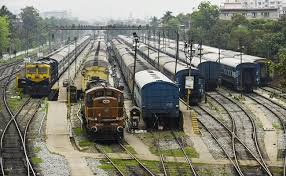 By Karli Srinivasulu in Hyderabad, April 7, 2020: The corona pandemic that has gripped the humanity poses a challenge unknown and unparallel in the recorded history of mankind. If the phenomenon is global the challenge is also very much local, specific and contextual. If it has brought the starkly dark side of globalization it also highlights the importance of the local to human existence which is grossly undermined in the onrush of globalization.
By Karli Srinivasulu in Hyderabad, April 7, 2020: The corona pandemic that has gripped the humanity poses a challenge unknown and unparallel in the recorded history of mankind. If the phenomenon is global the challenge is also very much local, specific and contextual. If it has brought the starkly dark side of globalization it also highlights the importance of the local to human existence which is grossly undermined in the onrush of globalization.
In the Indian context, the challenge has to be met at both the national and provincial levels. The governments at the centre and states are understandably under great stress to contain the spread of the virus as containment alone is the solution to this infection at the present stage.
How to meet this colossal challenge? As stories of heroic effort roll out, some states like Kerala, Telangana, Odisha seem to have evolved a pattern of policy response, administrative execution, resource mobilization – human and material and popular preparedness.
The attempt here is basically to narrate the experience of the state of Telangana for wider audience so that the policy pattern to be deciphered here could be of some help to other states and contexts. For one of the important modes of meeting a crisis is openness to ideas and practices from different times, contexts and experiences.
The state of Telangana which was formed in 2014 following a protracted statehood movement has been under the rule of the Telangana Rashtra Samithi (TRS), the party which was at the helm of the movement. The Telangana state was one of the few states to understand the gravity of the situation and realize the necessity of the statewide lockdown as the only viable way of containing the viral spread. Of course,  this decision followed the Sunday’s national level ‘Janata curfew’ and preceded the centre’s declaration of national lockdown. Five districts of the state are declared by the union government as part of the list of 75 most affected districts in the country. This is seen as indicative of the potentially explosive situation awaiting the state.
this decision followed the Sunday’s national level ‘Janata curfew’ and preceded the centre’s declaration of national lockdown. Five districts of the state are declared by the union government as part of the list of 75 most affected districts in the country. This is seen as indicative of the potentially explosive situation awaiting the state.
Telangana in recognition of the seriousness of issue tried to put in place a policy frame. The policy response to the crisis thus evolved is centred around the government and people seen as two sides of the spectrum; of course, with a focus on the whole range of mediations that form either actively or otherwise the state-citizen rubric.
There are three dimensions to this response.
Firstly, identifying the actual and potential carriers of the disease – monitoring and quarantining them, and treating them.
Secondly, to use the information with the government to enhance the state capacity to effectively meet the challenge administratively and to prepare the people to face it.
Thirdly, to address the needs of different sections of the society with an attention to their specific contexts so that the vulnerable sections would be subjected to lesser pain – an inevitable consequence of any prolonged lockdown.
Monitoring:
The Telangana government has displayed a tremendous proactive and expansive effort to identify the sources of transmission. There are said to be around 20,000 people who have returned from abroad in the last one month. A coordinated plan is evolved to identify and monitor the returnees, their close contacts and those who could potentially be infected by mapping their movement through visual footage and field information. This effort is made by not only involving the civil, police bureaucracy and the health administration but later also by roping in the elected local body representatives as active stakeholders in this gigantic task. This step in fact could be seen evolving popular acceptance and also reducing the excesses that could visit if it were to be an entirely bureaucratic exercise.
The exercise included the mapping of the state capacity in terms of available medical, nursing and paramedical staff, availability of hospital beds and ventilators, etc and possibility of creating additional capacity in case of future need. The daily visits by the health staff to those who are home quarantined is part of this effort. All this sought to be done by using the public health resources to begin with.
Welfare measures
 The TRS government in Telangana has been known for its welfarist populist policies like Rs 1 kilo rice, pension schemes for the old, orphans, widows, handicapped and a variety of schemes for the farmers, artisanal and occupational communities. What has come in handy in the effective implementation of these schemes by targeting the deserving groups is the data collected through household survey conducted after the formation of the state. The decision to provide 12 kilos of free rice and Rs 1500 to all the BPL white card holders is a move in the direction of confidence building that the government cares for the poor and vulnerable.
The TRS government in Telangana has been known for its welfarist populist policies like Rs 1 kilo rice, pension schemes for the old, orphans, widows, handicapped and a variety of schemes for the farmers, artisanal and occupational communities. What has come in handy in the effective implementation of these schemes by targeting the deserving groups is the data collected through household survey conducted after the formation of the state. The decision to provide 12 kilos of free rice and Rs 1500 to all the BPL white card holders is a move in the direction of confidence building that the government cares for the poor and vulnerable.
There is also a huge presence of migrant labour from states like Bihar, Odisha, Chhattisgarh, Jharkhand, UP not only in the metropolis of Hyderabad but also in the district and even smaller towns engaged in a variety of processes – construction, hamali work in mandis, rice mills, brick making, etc. Hyderabad in the context of neoliberal development has witnessed a massive expansion in sectors like the IT and infrastructure leading to the concentration of migrant population both as the white collar employees and casual labour. The growth of the city fanning out into the neighbouring rural countryside has led to the growth of peri-urban centres. The labour in these areas being largely migrant, casual and daily wage earners dispersed in the neighborhood are not covered by the welfare safety net. With the lockdown declared and this section with meager savings and with no social security would be subjected to large scale starvation. What is important to note is the intricate awareness of the awaited woes of these people and the government’s readiness to address them by opening free food centres in urban areas run by the municipal bodies with the help of local civil society initiatives.
 In the last one week ever since lockdown was declared the Chief Minister K Chandrasekhar Rao (KCR) has addressed three elaborate press conferences. Popular and articulate leader that he is his whole effort has been to chase away the apparent dystopic gloom and instill confidence in the anxious people. In the times like the present crisis, truth becomes the casualty. It must be said to KCR’s credit that he could largely succeed in dispelling the gloom which could be a lesson in leadership for those facing similar challenge especially when it is rendered arduous in the times of social media boom and perhaps TRP rate craving electronic media.
In the last one week ever since lockdown was declared the Chief Minister K Chandrasekhar Rao (KCR) has addressed three elaborate press conferences. Popular and articulate leader that he is his whole effort has been to chase away the apparent dystopic gloom and instill confidence in the anxious people. In the times like the present crisis, truth becomes the casualty. It must be said to KCR’s credit that he could largely succeed in dispelling the gloom which could be a lesson in leadership for those facing similar challenge especially when it is rendered arduous in the times of social media boom and perhaps TRP rate craving electronic media.
Three aspects can be identified in this context: firstly, his press addresses have not been general and abstract in their appeal. Instead every statement is buttressed with facts and figures; secondly, he has shown an informed attention to the interstices of the Telangana society and economy and its dynamics by specifying the problems and challenges and how the government plans to overcome them. His experience of being in the lead of the Telangana movement and being in power since 2014 are clearly to his advantage. Thirdly, more importantly, the fight, instead of being owned up by one individual which usually is the case, is sought to be projected as a collective tireless effort of the different branches of the government, the representatives of them sharing the dais with him in the press meetings. The due recognition to all the actors, the principal ones being the civil administration, police and health departments and local bodies, seems to have forged solidarity and strengthen the will to fight.
Coordinated effort
What is noteworthy is the attempt to forge coordination between the administrative, representative and the popular to meet the gigantic task ahead. A structure could be identified in this with a state level committee comprising of the state level heads of the different departments and a minister coordinating efforts at the district level and elected municipal counsellors in the towns and sarpanch and ward members in the villages. With the elections conducted to the urban bodies recently the elected members are expected to have not just familiarity but an intimate knowledge of the specific constituencies. Their participation being an added advantage to the lockdown also imparts a softer side to an otherwise primarily law and order matter and plays a crucial role in the implementation of relief to popular classes. This clearly is an instance of political craftsmanship.
 This being the rabi season is critical to the agrarian society which Telangana predominantly is. The crops being in the advanced stage and expected to be harvested in a month’s time the farmers are obviously worried. Claiming himself to be a ‘kapu’ ( meaning farmer) and therefore in a position to understand the anxiety of the farming community he sought to assure irrigation to the crops in an advanced stage and government taking the responsibility of procuring the yield from the farmer’s field itself with guaranteed support price. The major worry of the farmers is the marketing of the produce in a mandi dominated by the greedy agents. KCR sought to assuage the worries of the farmers through these decisions.
This being the rabi season is critical to the agrarian society which Telangana predominantly is. The crops being in the advanced stage and expected to be harvested in a month’s time the farmers are obviously worried. Claiming himself to be a ‘kapu’ ( meaning farmer) and therefore in a position to understand the anxiety of the farming community he sought to assure irrigation to the crops in an advanced stage and government taking the responsibility of procuring the yield from the farmer’s field itself with guaranteed support price. The major worry of the farmers is the marketing of the produce in a mandi dominated by the greedy agents. KCR sought to assuage the worries of the farmers through these decisions.
From the above narrative it may be deciphered that timing, transparency, trust and collective effort by forging coordination at the political, administrative and popular levels are necessary to strengthen a fight against an emergency liken COVID-19. The governance measures like free rice, monetary support and free food Annapurna outlets for the poor and needy, procurement of agricultural produce from the farm itself are some of the crucial initiatives meant to avert the impending disaster. The experience of Telangana shows that KCR could make an attempt to rise up to the occasion both as an administrator and as a popular leader and prepare the state to face the challenge.
This experience could be of help in waging a collective fight in other states as well.
• The author is a Senior Fellow, Indian Council of Social Science Research (ICSSR) and a former Professor of Political Science, Osmania University, Hyderabad. The article was first published in Asiaville News.


Leave a Reply
2 Comments on "What can Telangana teach us in facing COVID 19 Challenge?"
Congratulations sir. But we need to focus on the concerns relating to delivery of services and goods at the ground level, which are lacking in the discussion.
Further we need to juxtapose other state Governments initiatives in this regard. For instance states like Odisha and Northeastern states are able to minimise the corona Covid 19 incidents compared to other states.